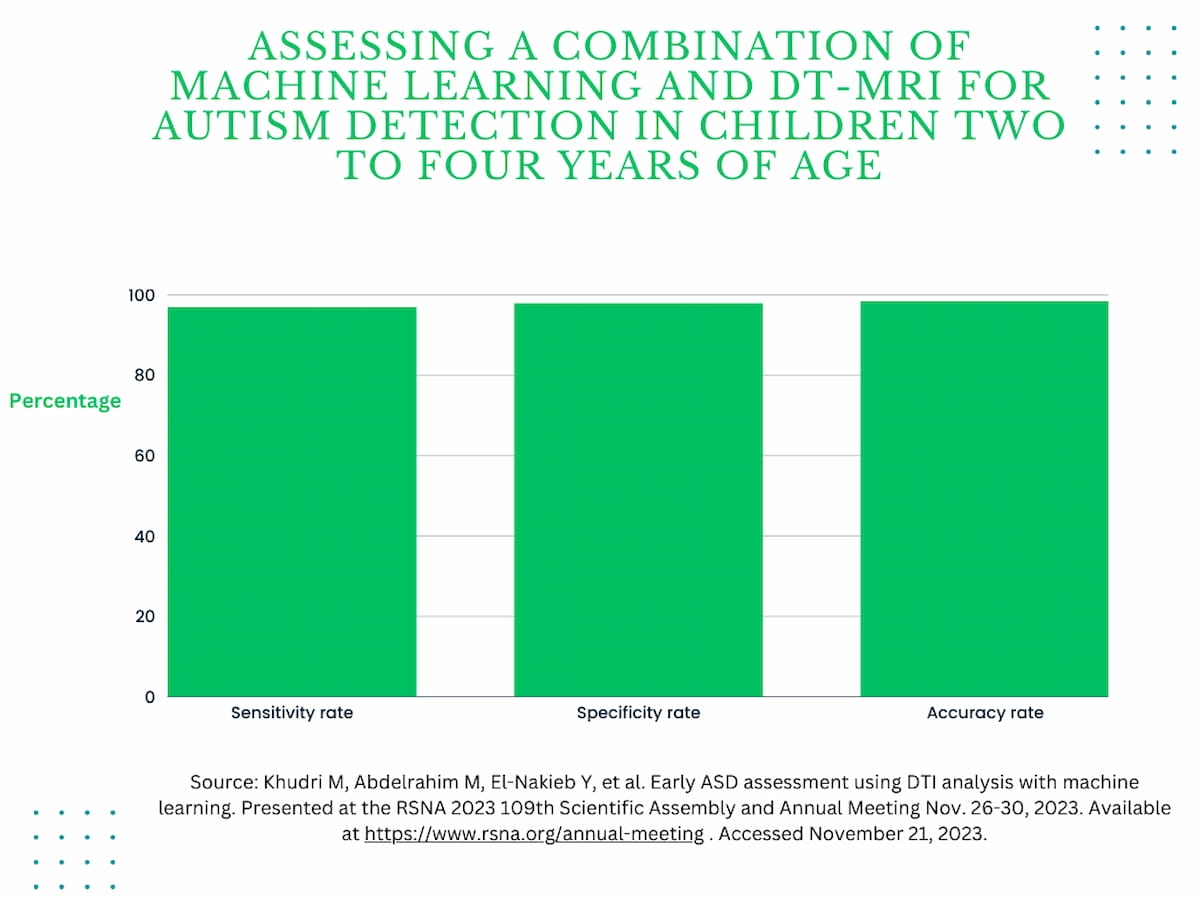While a recent report issued by the Centers for Disease Control and Prevention (CDC) noted that 30 percent of children with autism were not diagnosed at eight years of age, emerging research suggests that a combination of artificial intelligence (AI) and diffusion tensor magnetic resonance imaging (DT-MRI) facilitates autism detection in children between two to four years of age.1,2
In a study to be presented at the annual Radiological Society of North America (RSNA) conference next week in Chicago, researchers examined the use of a machine learning-based system that assesses connectivity markers extracted from DT-MRI brain scans that allow visualization of how water travels in white matter tracts. The study cohort was comprised of 126 children with autism and 100 normally developing children. All children in the cohort were between two to four years of age, according to the study.2
The researchers found that the machine learning-based system exhibited a 97 percent sensitivity rate, a 98 percent specificity rate and a 98.5 percent accuracy rate in diagnosing autism spectrum disorder (ASD).2
Noting that the machine learning system provides a detailed report including affected neural pathways, potential impact on brain functionality and grades for autism severity, the study authors suggested the modality could play a significant role in the diagnostic workup of patients with ASD.
"Imaging offers the promise of quickly detecting autism in an objective fashion," noted study co-author Gregory N. Barnes, M.D., Ph.D., a professor of neurology and director of the Norton Children’s Autism Center in Louisville, Kentucky. "We envision an autism assessment that begins with DT-MRI followed by an abbreviated session with a psychologist to confirm the results and guide parents on next steps. This approach could reduce the psychologists' workload by up to 30%."
Dr. Barnes pointed out that DT-MRI offers unique advantages in this patient population.
"Autism is primarily a disease of improper connections within the brain," emphasized Dr. Barnes. "DT-MRI captures these abnormal connections that lead to the symptoms that children with autism often have, such as impaired social communication and repetitive behaviors."
Three Key Takeaways
- Early detection through AI and DT-MRI. The study highlights that a combination of artificial intelligence (AI) and diffusion tensor magnetic resonance imaging (DT-MRI) can facilitate the early detection of autism spectrum disorder (ASD) in children between two to four years of age. This approach offers a promising method to identify ASD at a younger age compared to the conventional diagnostic timeline.
- High diagnostic accuracy. The machine learning-based system, utilizing connectivity markers extracted from DT-MRI brain scans, demonstrated impressive diagnostic accuracy for ASD. With a 97 percent sensitivity rate, a 98 percent specificity rate, and a 98.5 percent accuracy rate, the system showed robust performance in distinguishing between children with autism and normally developing children within the specified age group.
- Potential impact on diagnostic workflow. The researchers suggest that implementing this AI and DT-MRI-based diagnostic approach could streamline the diagnostic process for ASD. By providing a detailed report on affected neural pathways, potential impact on brain functionality, and grades for autism severity, the system could play a significant role in the diagnostic workup. This has the potential to reduce the workload of psychologists by up to 30%, offering a more efficient and objective assessment method for autism spectrum disorder.
(Editor’s note: For related content, see “New MRI Study Identifies Signature White Matter Connectivity Patterns in People with Autism” and “Study Says Quantitative MRI Can Detect Biomarkers of Neurological Conditions in Adolescents with Extremely Preterm Birth.”)
Mohammed Khudri, B.Sc, a co-author of the study, added that the machine learning system could facilitate earlier intervention that may significantly enhance the quality of life for patients with ASD.
"Our approach is a novel advancement that enables the early detection of autism in infants under two years of age," added Khudri, a visiting research scholar at the University of Louisville in Kentucky. "We believe that therapeutic intervention before the age of three can lead to better outcomes, including the potential for individuals with autism to achieve greater independence and higher IQs."
The study authors are reportedly working toward securing 510(k) clearance from the Food and Drug Administration (FDA) for the machine learning system.
References
1. Autism and Developmental Disabilities Monitoring (ADDM) Network. Community Report on Autism 2023: a Snapshot of Autism Spectrum Disorder Among 4-year-old and 8-year-old Children in Multiple Communities Across the United States in 2023. Centers for Disease Control and Prevention (CDC). Available at: https://www.cdc.gov/ncbddd/autism/addm-community-report/index.html . Accessed November 21, 2023.
2. Khudri M, Abdelrahim M, El-Nakieb Y, et al. Early ASD assessment using DTI analysis with machine learning. Presented at the RSNA 2023 109th Scientific Assembly and Annual Meeting Nov. 26-30, 2023. Available at https://www.rsna.org/annual-meeting . Accessed November 21, 2023.
